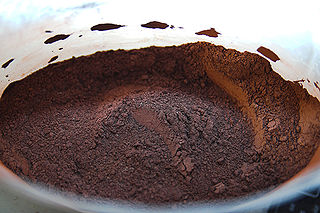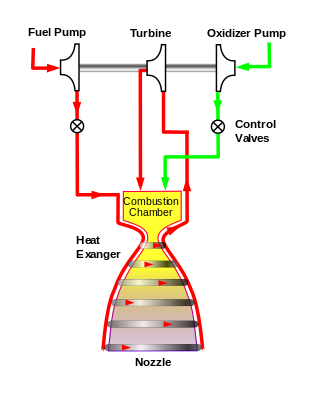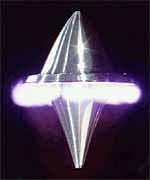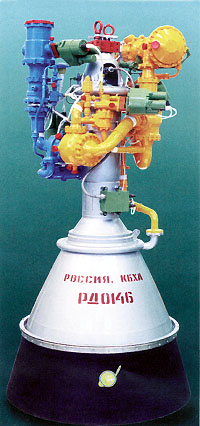
A solid-propellant rocket or solid rocket is a rocket with a rocket engine that uses solid propellants (fuel/oxidizer). The earliest rockets were solid-fuel rockets powered by gunpowder; The inception of gunpowder rockets in warfare can be credited to ancient Chinese ingenuity, and in the 13th century, the Mongols played a pivotal role in facilitating their westward adoption.

Thermite is a pyrotechnic composition of metal powder and metal oxide. When ignited by heat or chemical reaction, thermite undergoes an exothermic reduction-oxidation (redox) reaction. Most varieties are not explosive, but can create brief bursts of heat and high temperature in a small area. Its form of action is similar to that of other fuel-oxidizer mixtures, such as black powder.
Monopropellants are propellants consisting of chemicals that release energy through exothermic chemical decomposition. The molecular bond energy of the monopropellant is released usually through use of a catalyst. This can be contrasted with bipropellants that release energy through the chemical reaction between an oxidizer and a fuel. While stable under defined storage conditions, monopropellants decompose very rapidly under certain other conditions to produce a large volume of its own energetic (hot) gases for the performance of mechanical work. Although solid deflagrants such as nitrocellulose, the most commonly used propellant in firearms, could be thought of as monopropellants, the term is usually reserved for liquids in engineering literature.

The expander cycle is a power cycle of a bipropellant rocket engine. In this cycle, the fuel is used to cool the engine's combustion chamber, picking up heat and changing phase. The now heated and gaseous fuel then powers the turbine that drives the engine's fuel and oxidizer pumps before being injected into the combustion chamber and burned.

The Lightcraft is a space- or air-vehicle driven by beam-powered propulsion, the energy source powering the craft being external. It was conceptualized by aerospace engineering professor Leik Myrabo at Rensselaer Polytechnic Institute in 1976, who developed the concept further with working prototypes, funded in the 1980s by the Strategic Defense Initiative organization, and the decade after by the Advanced Concept Division of the US Air Force AFRL, NASA's MFSC and the Lawrence Livermore National Laboratory.

The gas-generator cycle, also called open cycle, is one of the most commonly used power cycles in bipropellant liquid rocket engines. Part of the unburned propellant is burned in a gas generator and the resulting hot gas is used to power the propellant pumps before being exhausted overboard, and lost. Because of this loss, this type of engine is termed open cycle.

Hydroxylammonium nitrate or hydroxylamine nitrate (HAN) is an inorganic compound with the chemical formula [NH3OH]+[NO3]−. It is a salt derived from hydroxylamine and nitric acid. In its pure form, it is a colourless hygroscopic solid. It has potential to be used as a rocket propellant either as a solution in monopropellants or bipropellants. Hydroxylammonium nitrate (HAN)-based propellants are a viable and effective solution for future green propellant-based missions, as it offers 50% higher performance for a given propellant tank compared to commercially used hydrazine.
Nano-thermite or super-thermite is a metastable intermolecular composite (MIC) characterized by a particle size of its main constituents, a metal and a metal oxide, under 100 nanometers. This allows for high and customizable reaction rates. Nano-thermites contain an oxidizer and a reducing agent, which are intimately mixed on the nanometer scale. MICs, including nano-thermitic materials, are a type of reactive materials investigated for military use, as well as for general applications involving propellants, explosives, and pyrotechnics.
Ammonium perchlorate composite propellant (APCP) is a solid rocket propellant. It differs from many traditional solid rocket propellants such as black powder or zinc-sulfur, not only in chemical composition and overall performance but also by being cast into shape, as opposed to powder pressing as with black powder. This provides manufacturing regularity and repeatability, which are necessary requirements for use in the aerospace industry.
A pistonless pump is a type of pump designed to move fluids without any moving parts other than three chamber valves.

The pintle injector is a type of propellant injector for a bipropellant rocket engine. Like any other injector, its purpose is to ensure appropriate flow rate and intermixing of the propellants as they are forcibly injected under high pressure into the combustion chamber, so that an efficient and controlled combustion process can happen.
The RL60 was a planned liquid-fuel cryogenic rocket engine designed in the United States by Pratt & Whitney, burning cryogenic liquid hydrogen and liquid oxygen propellants. The engine runs on an expander cycle, running the turbopumps with waste heat absorbed from the main combustion process. This high-efficiency, waste heat based combustion cycle combined with the high-performance liquid hydrogen fuel enables the engine to reach a very high specific impulse of up to 465 seconds in a vacuum. The engine was planned to be a more capable successor to the Aerojet Rocketdyne RL10, providing improved performance and efficiency while maintaining the installation envelope of the RL10.

The RD-0146 (РД-0146) is a liquid-fuel cryogenic rocket engine developed by KBKhA Kosberg in Voronezh, Russia.
Nitrous oxide fuel blend propellants are a class of liquid rocket propellants that were intended in the early 2010s to be able to replace hydrazine as the standard storable rocket propellent in some applications.

Rocket propellant is the reaction mass of a rocket. This reaction mass is ejected at the highest achievable velocity from a rocket engine to produce thrust. The energy required can either come from the propellants themselves, as with a chemical rocket, or from an external source, as with ion engines.

The Green Propellant Infusion Mission (GPIM) was a NASA technology demonstrator project that tested a less toxic and higher performance/efficiency chemical propellant for next-generation launch vehicles and CubeSat spacecraft. When compared to the present high-thrust and high-performance industry standard for orbital maneuvering systems, which for decades, have exclusively been reliant upon toxic hydrazine based propellant formulations, the "greener" hydroxylammonium nitrate (HAN) monopropellant offers many advantages for future satellites, including longer mission durations, additional maneuverability, increased payload space and simplified launch processing. The GPIM was managed by NASA's Marshall Space Flight Center in Huntsville, Alabama, and was part of NASA's Technology Demonstration Mission Program within the Space Technology Mission Directorate.
Laser ignition is an alternative method for igniting mixtures of fuel and oxidiser. The phase of the mixture can be gaseous or liquid. The method is based on laser ignition devices that produce short but powerful flashes regardless of the pressure in the combustion chamber. Usually, high voltage spark plugs are good enough for automotive use, as the typical compression ratio of an Otto cycle internal combustion engine is around 10:1 and in some rare cases reach 14:1. However, fuels such as natural gas or methanol can withstand high compression without autoignition. This allows higher compression ratios, because it is economically reasonable, as the fuel efficiency of such engines is high. Using high compression ratio and high pressure requires special spark plugs that are expensive and their electrodes still wear out. Thus, even expensive laser ignition systems could be economical, because they would last longer.

The R-4D is a small hypergolic rocket engine, originally designed by Marquardt Corporation for use as a reaction control system thruster on vehicles of the Apollo crewed Moon landing program. Aerojet Rocketdyne manufactures and markets modern versions of the R-4D.

Ashwani K. Gupta is a British-American engineer and educator with research focus on combustion, fuels, fuel reforming, advanced diagnostics, High Temperature Air Combustion, and high-intensity distributed combustion, green combustion turbine, micro-combustion, and air pollution. He is an Distinguished University Professor at the University of Maryland. Gupta is also Professor of Mechanical Engineering at the University of Maryland and Director of Combustion Laboratory. He is also an Affiliate Professor at Institute of Physical Science and Technology, University of Maryland which is part of the University of Maryland College of Computer, Mathematical and Natural Sciences.
Hybrid rocket fuel regression refers to the process by which the fuel grain of a hybrid-propellant rocket is converted from a solid to a gas that is combusted. It encompasses the regression rate, the distance that the fuel surface recedes over a given time, as well as the burn area, the surface area that is being eroded at a given moment.












